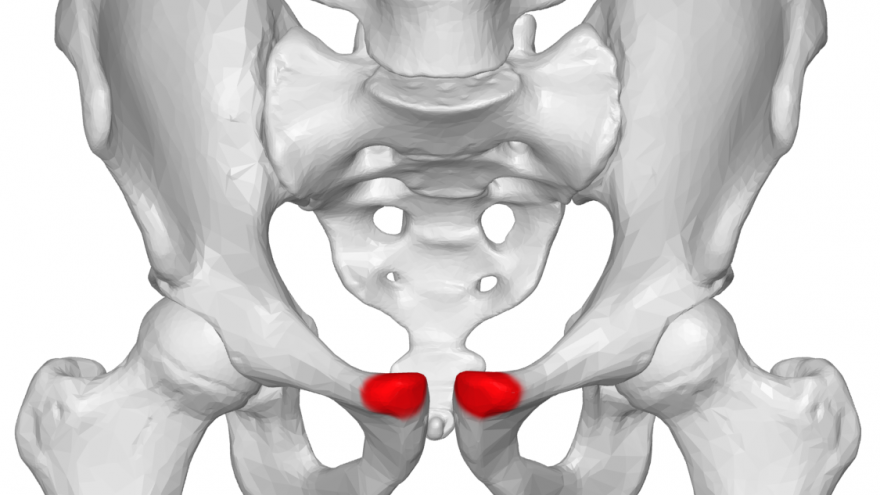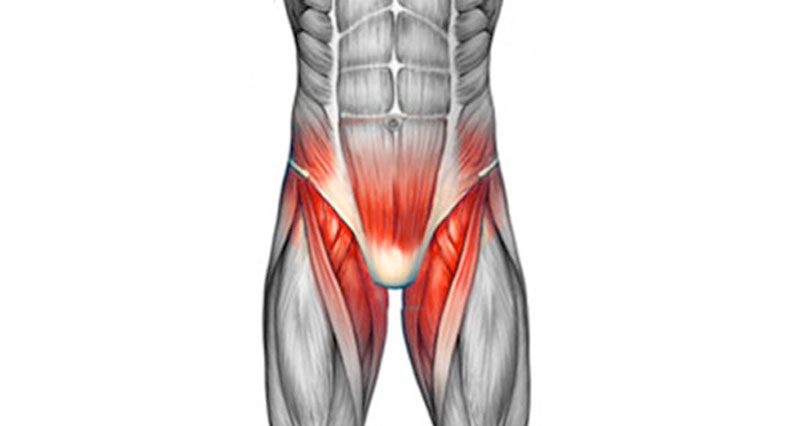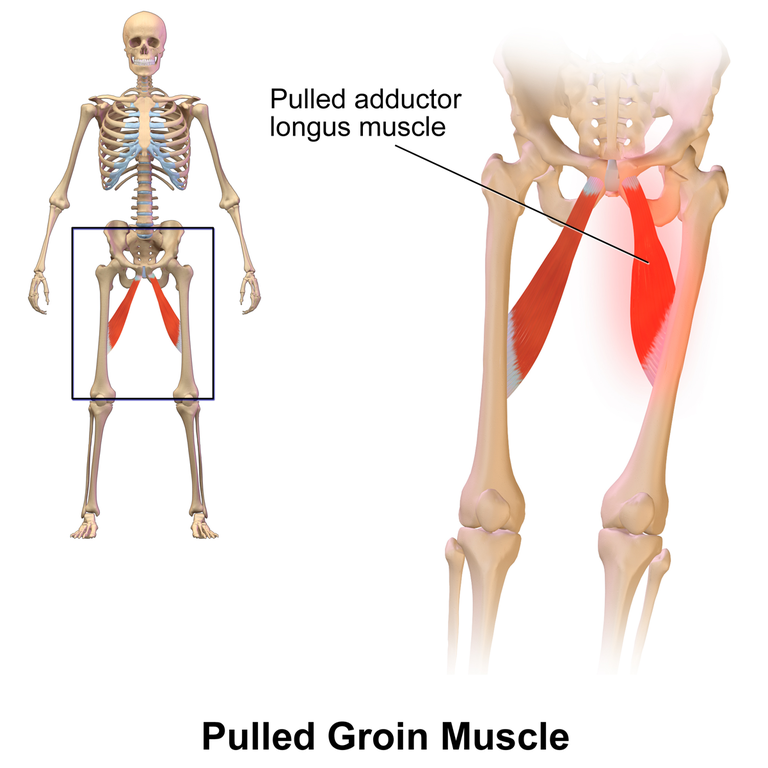Groin Pain After Running: 9 Causes & Quick Solutions

Groin pain can be caused by various factors, ranging from minor muscle strains to more serious medical conditions. Common causes of groin pain in runners include overuse injuries, hip flexor injury, and groin strain.
Runners often experience muscle strain as a result of vigorous training. Pain or discomfort can result in many complex questions, especially when the groin area is involved.
- What causes groin pain in runners?
- How do you differentiate between running injury and discomfort you can run through?
As always, we have answers to your burning questions.
Where is the Groin?
Before answering questions about groin injuries, it is important to identify the area referred to as the groin. Your groin is where your torso ends, and your legs begin on the front and inside of your legs. Located in front of the hips and pelvis, the groin lies between the stomach and thighs.
The major muscle groups of the groin are:
- Adductor Muscles: Located in the medial compartment of the thigh, five muscles comprise this group.
- Hip Flexors: Hip flexors cross the hip. This group of muscles at the top of your thighs plays a crucial role in moving the lower body.
- Inguinal Ligament: This crucial ligament connects the oblique muscle to your pelvis.

Why Does My Groin Hurt After Running?
Many different things can cause groin pain. Most medical professionals categorize groin pain into four classifications: adductor-related, iliopsoas-related, inguinal-related, and pubic-related.
Here are the most common causes of groin pain in runners.
- Overuse Injuries: Anytime you engage in repetitive motion, increase training quickly, or run too many days without a rest day, you risk an overuse injury.
- Groin Strain or Pull: A strain is a pull in the groin area muscles. Often, people quantify the injury by calling a strain less severe than a pull, but they are essentially the same thing.
- Pelvic Problems: Athletes lacking stability in the core, pelvis, and hips can cause too much strain on the tendons and pubic bone. This is just one reason not to ignore groin pain.
- Hip Arthritis: A degenerative condition that means you have thinning cartilage between bones in your hip joint; there can be rubbing and crepitus that causes groin pain.
- Hip Joint Issues: Hip problems such as a hip stress fracture, cartilage tear, or hip impingement can all present as groin pain and hip pain.
- Hip Stress Fracture: Usually caused by micro-traumas to the hip area, stress fractures are a result of overuse.
- Osteitis Pubis: Chronic groin pain in athletes related to musculature imbalance and pelvis instability, this issue can be treated with physical therapy.
- Adductor/Inguinal Tendinopathy: An inflammatory injury in the muscle’s tendons; this is usually an overuse injury. An adductor strain is located in the inner thigh.
- Athletic Pubalgia: Also known as a sports hernia, some people who experience groin pain have this problem. Symptoms of this include increased pain when coughing and sneezing.

How Do I Know if My Groin Pain is Serious?
If your discomfort improves after warming up or easy movement or improves with an over-the-counter anti-inflammatory drug, it is likely not serious.
On the other hand, if you are experiencing sharp pain, pain that does not improve with rest, or discomfort so severe it is impeding your quality of life, you should probably see a sports medicine doctor.
Mild groin pain after running could just mean you need some gentle stretching and flexibility work. Too many runners fail to warm up and stretch their muscles adequately.
Treating Groin Pain
- Rest: When experiencing groin pain, you should start by giving yourself some rest and recovery time. Taking a couple of weeks off helps rest those groin muscles, and then you can return to some activity.
- Ice: At the onset of injury, it will help decrease inflammation by using ice for 10-20 minutes multiple times daily.
- Easy Efforts: After taking some time off, be certain to test things out with some easy efforts. If you return to an activity too hard or fast, you will likely undo any good you accomplished with time off.
After taking some time off and babying the groin, if you try to return to easy activity and the pain returns immediately, it is time to see a sports medicine doctor for a diagnosis.
Your physician might prescribe some time with a physical therapist to help you with the problem.
6 Ways to Prevent Groin Pain
- Warm Up: Proper warm-up before athletic activity can go a long way to avoiding injury and keeping an athlete pain-free.
- Dynamic Stretching: As part of a warm-up, it is important to engage in dynamic stretching, which involves getting the muscles ready to work. Tight hip flexors, adductors, and hamstrings will increase an athlete’s risk of groin injuries, which makes stretching very beneficial for prevention.
- Drills: Sport-specific drills are another way to prepare your body for work and also help prevent injury.
- Cool Down: An often neglected part of the workout is the essential act of cooling down the body. This can include easy post-workout movement, such as jogging or walking, followed by stretching.
- Foam Rolling: While many of us use a foam roller when injured, it is good practice to foam roll regularly.
- Strength Training: Studies show consistent strength training can greatly reduce groin injuries.
Latest Articles
 Is Running on a Treadmill Easier Than Running Outside?Runners have their own preferences, whether it is treadmill running, running outside on the road, or exploring trails. So...
Is Running on a Treadmill Easier Than Running Outside?Runners have their own preferences, whether it is treadmill running, running outside on the road, or exploring trails. So... Is It OK to Use Trail Running Shoes on the Road?While trail running shoes can be used on roads, especially in situations where a runner encounters mixed terrains or pref...
Is It OK to Use Trail Running Shoes on the Road?While trail running shoes can be used on roads, especially in situations where a runner encounters mixed terrains or pref... How to Fix Sore Quads After Running?Rest, ice, gentle stretching, and over-the-counter pain relievers can help soothe sore quads after running. Also, ensure ...
How to Fix Sore Quads After Running?Rest, ice, gentle stretching, and over-the-counter pain relievers can help soothe sore quads after running. Also, ensure ... 10 Fruits With The Most Electrolytes to Replace Sports DrinksThese fruits are high in electrolytes such as potassium, magnesium, and calcium, essential for hydration, muscle function...
10 Fruits With The Most Electrolytes to Replace Sports DrinksThese fruits are high in electrolytes such as potassium, magnesium, and calcium, essential for hydration, muscle function...

